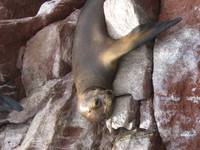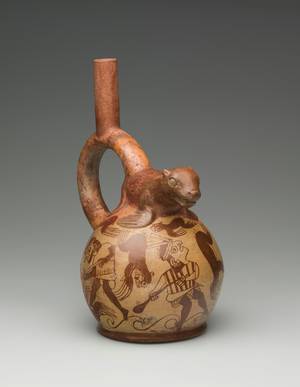Press Releases Archive
21.08.2014
Extinct form of Tuberculosis identified
Tübingen researchers analyse 1,000-year-old Peruvian skeletons, say tuberculosis first brought to the Americas by seals
Tuberculosis is one of the world’s deadliest infectious diseases, killing up to 2 million people every year. Public health efforts are complicated by the emergence of multi-drug resistant strains. The origins of the disease have long been debated; current research suggests that it evolved with humans in Africa, and spread from there tens of thousands of years ago following major human migrations. Tuberculosis strains in the New World today are closely related to European forms, implying an introduction after Spanish contact. However, characteristic changes in skeletons and mummies over one thousand years old from both North and South America suggest that the disease was present for hundreds of years before European contact. “We have long argued that this represents a form of tuberculosis, based upon diagnostic skeletal changes and more recently, molecular evidence,” said Jane Buikstra, the member of the research group responsible for providing the archaeological samples. However, “the relationship of these older tuberculosis strains to those currently circulating in the Americas was a great mystery”, says Anne Stone, Professor of Anthropology at Arizona State University and one of the lead investigators of the new study.
Research teams from the University of Tübingen, Arizona State University, the Wellcome Trust Sanger Institute in the UK, and the Swiss Institute for Tropical and Public Health have analysed ancient tuberculosis genomes of three 1,000-year old disease victims from Peru. Their surprising finding was that the closest relative of the ancient New World disease are strains circulating today in seals and sea lions. Furthermore tuberculosis as we know it today may be much younger than originally thought, perhaps having emerged only about 6,000 years ago. The results are published in the online issue of the journal Nature.
“The relationship to the sea lions was unexpected,” comments Sebastien Gagneux, from the Swiss Tropical and Public Health Institute. “This strain can make people ill today, but it is extremely rare and certainly not a common form of tuberculosis infection in humans.”
“The connection with seals and sea lions is important to explain how a mammalian-adapted pathogen that evolved in Africa around 6,000 years ago could have reached Peru 5,000 years later,” explains Johannes Krause, professor of the University of Tübingen and director of the Max Planck Institute for History and Sciences in Jena. Krause explains that the most plausible scenario for disease transmission is seals having acquired it from one of its many hosts in Africa and swimming with it across ocean waters where the seals were hunted for food and thereby introduced the infection into New World human populations in South America and perhaps other places. “A marine introduction seems the most likely way that a mammalian-adapted disease could have reached humans in the Americas thousands of years after inundation of the Bering Land Bridge, when terrestrial movements into the Americas were no longer possible.”
It’s not yet known if this strain was restricted to ancient Peru, or whether it made its way into other areas. Whatever its ancient range, evidence points towards its later complete replacement by European strains. The relatively recent date for the emergence of tuberculosis raises questions about the disease’s evolutionary history, especially in the light of archaeological evidence for tuberculosis older than 6,000 years, which has been reported by several groups. “A compelling prospect for future research will be to determine the relationship of these older forms to those currently circulating, and those yet to be isolated from other ancient remains,” says Kirsten Bos, a postdoctoral researcher at the University of Tübingen. “Analytical methods in ancient DNA have advanced to the point where such goals are within reach.”
 |  |  | |
| Sea lions at Isla Ballestas, Peru. Photos: Sara Marsteller |
 | |
Moche jar showing seal hunting with fineline painting and figural seal on top. Moche-culture, Peru, Phase III, 4.-6.th century A.D. Linden-Museum Stuttgart, Photo: Anatol Dreyer, Inventory-Number: 119020. |
Publication:
Kirsten I. Bos, Kelly M. Harkins, Alexander Herbig, Mireia Coscolla, Nico Weber, Iñaki Comas, Ste-phen A. Forrest, Josephine M. Bryant, Simon R. Harris, Verena J. Schuenemann, Tessa J. Camp-bell, Kerrtu Majander, Alicia K. Wilbur, Ricardo A. Guichon, Dawnie L. Wolfe Steadman, Della Collins Cook, Stefan Niemann, Marcel A. Behr, Martin Zumarraga, Ricardo Bastida, Daniel Huson, Kay Nieselt, Douglas Young, Julian Parkhill, Jane E. Buikstra, Sebastien Gagneux, Anne C. Stone, and Johannes Krause: Pre-Columbian Mycobacterial Genomes Reveal Seals as a Source of New World Human Tuberculosis. Nature, Advance Online Publication 20 August 2014, doi: 10.1038/nature13591
Contact:
Professor Dr. Johannes Krause
University of Tübingen - Institute for Scientific Archaeology (INA)
Director of Max Planck Institute for History and Sciences, Jena
Member of Senckenberg Centre for Human Evolution and Palaeoenvironment
Phone: +49 7071 29-74089, johannes.krause[at]uni-tuebingen.de
Dr. Kirsten Bos
University of Tübingen
Institute for Scientific Archaeology (INA)
Phone: +40 7071 29-77060, kirsten.bos[at]ifu.uni-tuebingen.de
